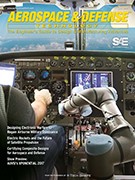Magazine

Aerospace & Defense Technology: February 2024
2024-02-08
Certified Machine Learning-Based Avionics: Unlocking Safer Revolutionizing Electronic Warfare: Unleashing the Power of High-Performance Software Defined Radios Deterministic and Modular Architecture for Embedded Vehicle Systems Approximating the Material Stresses and System Requirements for Hypersonic Flight Design Approaches for Established and Emerging RF Receiver Architectures Rydberg Technologies Shows Potential of Long-Range RF with Quantum Sensor at NetModX23 New Method to Measure Wind Speed Could Unlock Drones' Potential A fundamentally different approach to wind estimation using unmanned aircraft than the vast majority of existing methods. This method uses no on-board flow sensor and does not attempt to estimate thrust or drag forces. Report on Human Factors Issues Likely to Affect Air-Launched Effects This report reviews human factors research on the supervision of multiple unmanned vehicles (UVs) as it affects human integration with Air-Launched Effects (ALE).



















